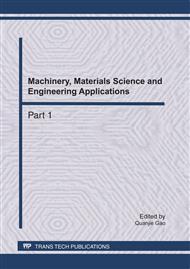[1]
T. Trindade, P. O'Brien and N. L. Pickett: Chem. Mater. Vol. 13 (2001), p.3843.
Google Scholar
[2]
R. Jayakrishnan and G. Hodes: Thin Solid Films Vol. 440 (2003), p.19.
Google Scholar
[3]
M. Ghosh and C. N. R. Rao: Chem. Phys. Lett. Vol. 393 (2004), p.493.
Google Scholar
[4]
M. Ristic, S. Popovic and S. Music: Mater. Lett. Vol. 58 (2004), p.2494.
Google Scholar
[5]
W. D. Shi, C. Wang, H. S. Wang and H. Zhang: Cryst. Growth Des. Vol. 6 (2006), p.915.
Google Scholar
[6]
H. D. Yu, D. S. Wang and M. Y. Han: J. Am. Chem. Soc. Vol. 129 (2007), p.2333.
Google Scholar
[7]
R. Kaur, A. V. Singh and R. M. Mehra: J. Non-Cryst. Solids Vol. 352 (2006), p.2335.
Google Scholar
[8]
W. T. Dong and C. S. Zhu: Opt. Mater. Vol. 22 (2003), p.227.
Google Scholar
[9]
A. Aakarinejad and A. Morsali: Mater. Lett. Vol. 62 (2008), p.478.
Google Scholar
[10]
Y. M. Zhou and X. Q. Xin: Chinese J. Inorg. Chem. Vol. 15 (1999), p.273.
Google Scholar
[11]
Y. Chen, J. M. Zhu, X. H. Zhu, G. B. Ma, Z. G. Liu and N. B. Min: Mater. Sci. Engineer B Vol. 99 (2003), p.52.
Google Scholar
[12]
Y. H. Chi, J. Zhuang, J. Yu and M. J. Tu: Chinese J. Inorg. Chem. Vol. 20 (2004), p.479.
Google Scholar
[13]
T. X. Wang, H. Xiao and Y. C. Zhang: Mater. Lett. Vol. 62 (2008), p.3736.
Google Scholar
[14]
Z. J. Wang, H. M. Zhang, L. G. Zhang, J. S. Yuan, S. G. Yan and C. Y. Wang: Nanotechnology Vol. 14 (2003), p.11.
Google Scholar
[15]
J. S. Liu, J. M. Cao, Z. Q. Li, G. B. Ji, S. G. Deng and M. B. Zheng: J. Mater. Sci. Vol. 42 (2007), p.1054.
Google Scholar
[16]
J. S. Liu, J. M. Cao, Z.Q. Li, G. B. Ji and M. B. Zheng: Chinese J. Inorg. Chem. Vol. 23 (2007), p.833.
Google Scholar
[17]
J. S. Liu, Z.Q. Li and J. M. Cao: Prog. Chem. Vol. 21 (2009), p.2542.
Google Scholar
[18]
Y. H. Wang: X-ray diffraction technology (Atomic Energy Publications Inc. Bei Jing, 1993).
Google Scholar
[19]
J. I. Pankove: Optical processes in semiconductors (Dover Publications Inc. New York, 1970).
Google Scholar
[20]
A. J. Skinner and J. P. LaFemina: Phys. Rev. B Vol. 45 (1992), p.3557.
Google Scholar
[21]
J. E. Jaffe, R. Pandey and A. B. Kunz: Phys. Rev. B Vol. 43 (1991), p.14030.
Google Scholar
[22]
B. S. Zou, R. B. Little, I. P. Wang and M. A. EI Sayed: Int. J. Quantum Chem. Vol. 72 (1999), p.439.
Google Scholar
[23]
N. Ueda, H. Maeda, H. Hosono and H. Kawazoe: J. Appl. Phys. Vol. 84 (1998), p.6174.
Google Scholar
[24]
A. D. Yoffe: Adv. Phys. Vol. 42 (1993), p.173.
Google Scholar
[25]
X. C. Wu, R. Y. Wang, B. S. Zou, L. Wang, S. M. Liu, J. R. Xu and W. Huang: J. Mater. Res. Vol. 13 (1998), p.604.
Google Scholar


